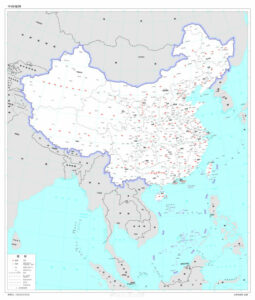By Kyle Aristophere T. Atienza, Reporter
THE PHILIPPINES has joined other nations in rejecting China’s new standard map that covers regions beyond its borders and claims most of the South China Sea, asking Beijing to respect international law.
Political analysts said the new map is part of China’s tactics to expand and alter the status quo through disinformation.
The Philippines has filed a protest regarding the map, which features a 10-dash line, Foreign Affairs Assistant Secretary Daniel R. Espiritu told a palace briefing on Thursday.
“Suffice it to say that we already protested against that,” he said. “Definitely, we’re not in favor of that, we reject that.”
China’s latest attempt to cement its claims over Philippine features and maritime zones is illegal and violates the 1982 United Nations Convention on the Law of the Sea (UNCLOS), the Department of Foreign Affairs (DFA) said in a separate statement.
It also cited the 2016 arbitral ruling by a United Nations-backed tribunal in the Hague that voided China’s claim to more than 80% of the South China Sea based on a nine-dash line etched on a 1946 map.
The 1946 map initially showed a U-shaped 11-dash line, two of which were removed by Mao Zedong in 1952 after abandoning Chinese claims in the Gulf of Tonkin amid warming ties with Vietnam.
The map’s 2023 edition features an additional dash located east of Taiwan, which China claims as its own.
The 2016 arbitral award that favored the Philippines in its sea dispute with China ruled that “maritime areas of the South China Sea encompassed by the relevant part of the ‘nine-dash line’ are contrary to the convention and without lawful effect to the extent that they exceed the geographic and substantive limits of China’s maritime entitlements under the convention,” DFA said.
It asked China to “act responsibly” and abide by its obligations under UNCLOS and the 2016 ruling, which has gained the support of the international community.
China’s latest map, which its Ministry of Natural Resources published on Monday, lays claim to almost the entire South China Sea, one of the world’s most important waterways.
“China is delusional,” Philippine Senator Ana Theresia “Risa” N. Hontiveros-Baraquel said in a statement. “This ‘map’ is Beijing’s desperate attempt to assert its lies and propaganda.”
“Since the creation of the People’s Republic of China in the late 1940s, China has consistently had an appetite to expand its territory,” said Don Mclain Gill, who teaches foreign relations at De La Salle University.
‘TWISTING THE NARRATIVE’
China has used a series of strategies throughout the 21st century to slowly alter the status quo without triggering a shooting war, he said in a Facebook Messenger chat.
“Along with its military, China’s strategy toward the South China Sea also banks on slowly twisting the narrative until it is accepted as a new status quo,” he said. “The maps, in particular, are an old and notorious habit of Beijing.”
Malaysia has also rejected the new Chinese map because it overlaps with its claims over Sabah, which is also claimed by the Philippines. The new map shows China’s “unilateral maritime claims,” it said.
The map also shows as being part of China the Indian state of Arunachal Pradesh, where Beijing fought a border war in 1962, and the Aksai Chin plateau, which links Tibet to western China.
The Indian Foreign Ministry also lodged a protest, saying the claims have no basis. “Such steps by the Chinese side only complicate the resolution of the boundary question,” it said.
Relations between the two countries have been complicated by a border clash in 2020 that led to the deaths of at least 20 Indian soldiers.
Experts have said Indian efforts to expand influence in Southeast Asia could minimize China’s dominance in the region.
The Chinese map also claims the Natuna islet cluster, which lies within Indonesia’s 200-nautical-mile exclusive economic zone. China had also claimed Natuna under the old nine-dash line map.
Indonesia, which is not a South China Sea claimant state, had yet to issue a statement.
“We are currently asking for information from the Indonesian Embassy in Beijing on the veracity of the news,” Foreign Ministry spokesman Teuku Faizasyah said on Wednesday, based on a report from BBC News Indonesia.
“This new 10-dash line map should be challenged by Taiwan and other neighboring countries since the Philippines has already won an arbitral award against the U-shaped nine-dash line,” Chester B. Cabalza, founder of Manila-based International Development and Security Cooperation, said via Messenger chat.
“Nonacceptance of China’s new regime of islands drawn in its 10-dash line map is an affirmation of the Hague ruling we won, which said Beijing should obey international law and the rules-based maritime order,” he added.

